PCP Report: Self-Regulation, Goal Attainment, & Leadership Insights
VerifiedAdded on 2022/11/27
|8
|3220
|300
Report
AI Summary
This report details a personal change project focused on improving self-regulation through emotional control, discipline, and analytics/feedback. The project involved yoga, meditation, journaling, and reading, resulting in an 80% achievement rate and a significant improvement in self-regulation scores. The report includes weekly monitoring data, evidence-based learning on the importance of self-regulation, and insights on leadership styles, particularly prosocial and transformational leadership. Key learnings emphasize the value of pursuing common goals, understanding followers, and fostering courage and growth. The project demonstrates the application of course knowledge to personal development and leadership effectiveness. Desklib provides past papers and solved assignments for students.
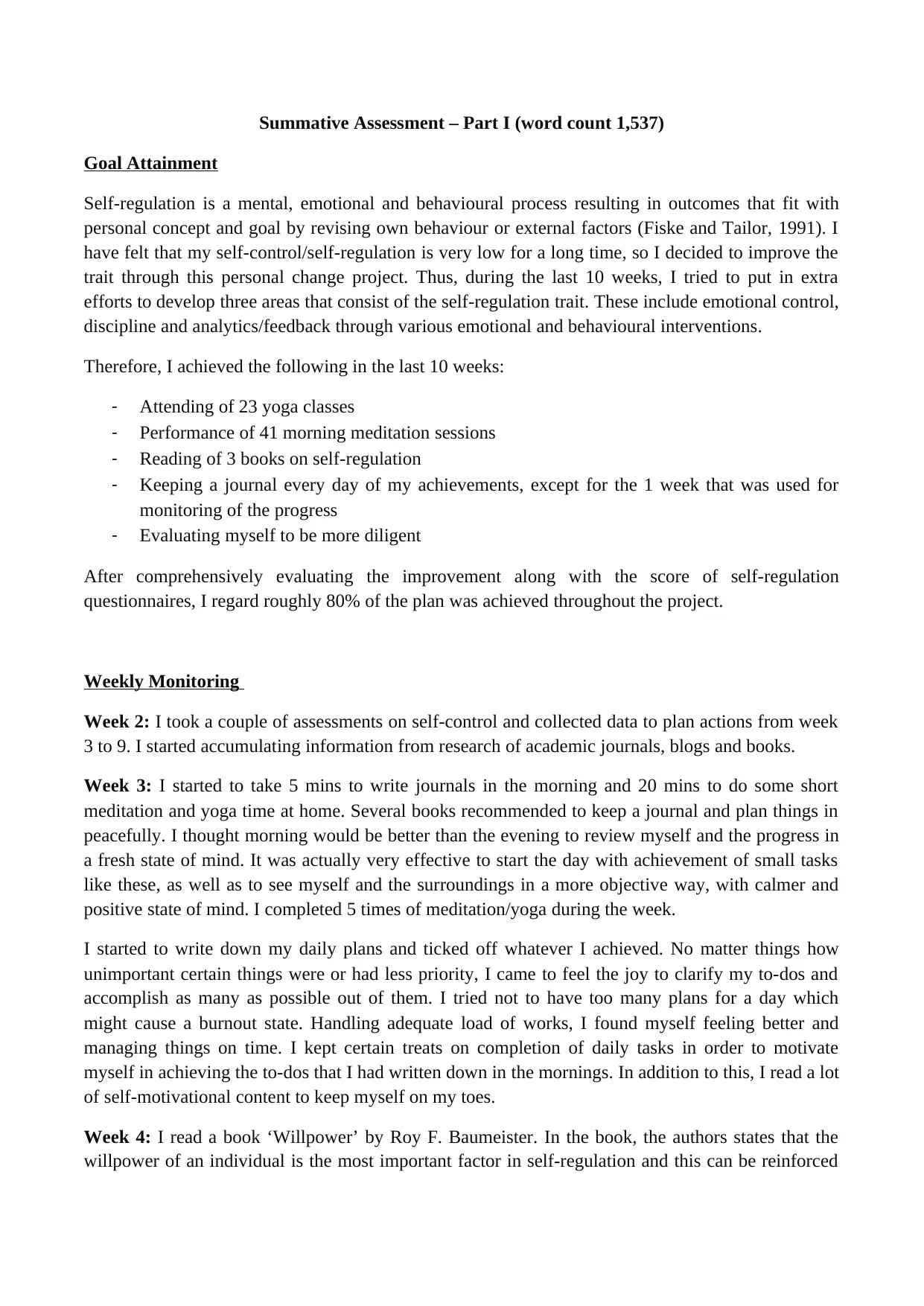
Summative Assessment – Part I (word count 1,537)
Goal Attainment
Self-regulation is a mental, emotional and behavioural process resulting in outcomes that fit with
personal concept and goal by revising own behaviour or external factors (Fiske and Tailor, 1991). I
have felt that my self-control/self-regulation is very low for a long time, so I decided to improve the
trait through this personal change project. Thus, during the last 10 weeks, I tried to put in extra
efforts to develop three areas that consist of the self-regulation trait. These include emotional control,
discipline and analytics/feedback through various emotional and behavioural interventions.
Therefore, I achieved the following in the last 10 weeks:
- Attending of 23 yoga classes
- Performance of 41 morning meditation sessions
- Reading of 3 books on self-regulation
- Keeping a journal every day of my achievements, except for the 1 week that was used for
monitoring of the progress
- Evaluating myself to be more diligent
After comprehensively evaluating the improvement along with the score of self-regulation
questionnaires, I regard roughly 80% of the plan was achieved throughout the project.
Weekly Monitoring
Week 2: I took a couple of assessments on self-control and collected data to plan actions from week
3 to 9. I started accumulating information from research of academic journals, blogs and books.
Week 3: I started to take 5 mins to write journals in the morning and 20 mins to do some short
meditation and yoga time at home. Several books recommended to keep a journal and plan things in
peacefully. I thought morning would be better than the evening to review myself and the progress in
a fresh state of mind. It was actually very effective to start the day with achievement of small tasks
like these, as well as to see myself and the surroundings in a more objective way, with calmer and
positive state of mind. I completed 5 times of meditation/yoga during the week.
I started to write down my daily plans and ticked off whatever I achieved. No matter things how
unimportant certain things were or had less priority, I came to feel the joy to clarify my to-dos and
accomplish as many as possible out of them. I tried not to have too many plans for a day which
might cause a burnout state. Handling adequate load of works, I found myself feeling better and
managing things on time. I kept certain treats on completion of daily tasks in order to motivate
myself in achieving the to-dos that I had written down in the mornings. In addition to this, I read a lot
of self-motivational content to keep myself on my toes.
Week 4: I read a book ‘Willpower’ by Roy F. Baumeister. In the book, the authors states that the
willpower of an individual is the most important factor in self-regulation and this can be reinforced
Goal Attainment
Self-regulation is a mental, emotional and behavioural process resulting in outcomes that fit with
personal concept and goal by revising own behaviour or external factors (Fiske and Tailor, 1991). I
have felt that my self-control/self-regulation is very low for a long time, so I decided to improve the
trait through this personal change project. Thus, during the last 10 weeks, I tried to put in extra
efforts to develop three areas that consist of the self-regulation trait. These include emotional control,
discipline and analytics/feedback through various emotional and behavioural interventions.
Therefore, I achieved the following in the last 10 weeks:
- Attending of 23 yoga classes
- Performance of 41 morning meditation sessions
- Reading of 3 books on self-regulation
- Keeping a journal every day of my achievements, except for the 1 week that was used for
monitoring of the progress
- Evaluating myself to be more diligent
After comprehensively evaluating the improvement along with the score of self-regulation
questionnaires, I regard roughly 80% of the plan was achieved throughout the project.
Weekly Monitoring
Week 2: I took a couple of assessments on self-control and collected data to plan actions from week
3 to 9. I started accumulating information from research of academic journals, blogs and books.
Week 3: I started to take 5 mins to write journals in the morning and 20 mins to do some short
meditation and yoga time at home. Several books recommended to keep a journal and plan things in
peacefully. I thought morning would be better than the evening to review myself and the progress in
a fresh state of mind. It was actually very effective to start the day with achievement of small tasks
like these, as well as to see myself and the surroundings in a more objective way, with calmer and
positive state of mind. I completed 5 times of meditation/yoga during the week.
I started to write down my daily plans and ticked off whatever I achieved. No matter things how
unimportant certain things were or had less priority, I came to feel the joy to clarify my to-dos and
accomplish as many as possible out of them. I tried not to have too many plans for a day which
might cause a burnout state. Handling adequate load of works, I found myself feeling better and
managing things on time. I kept certain treats on completion of daily tasks in order to motivate
myself in achieving the to-dos that I had written down in the mornings. In addition to this, I read a lot
of self-motivational content to keep myself on my toes.
Week 4: I read a book ‘Willpower’ by Roy F. Baumeister. In the book, the authors states that the
willpower of an individual is the most important factor in self-regulation and this can be reinforced
Paraphrase This Document
Need a fresh take? Get an instant paraphrase of this document with our AI Paraphraser
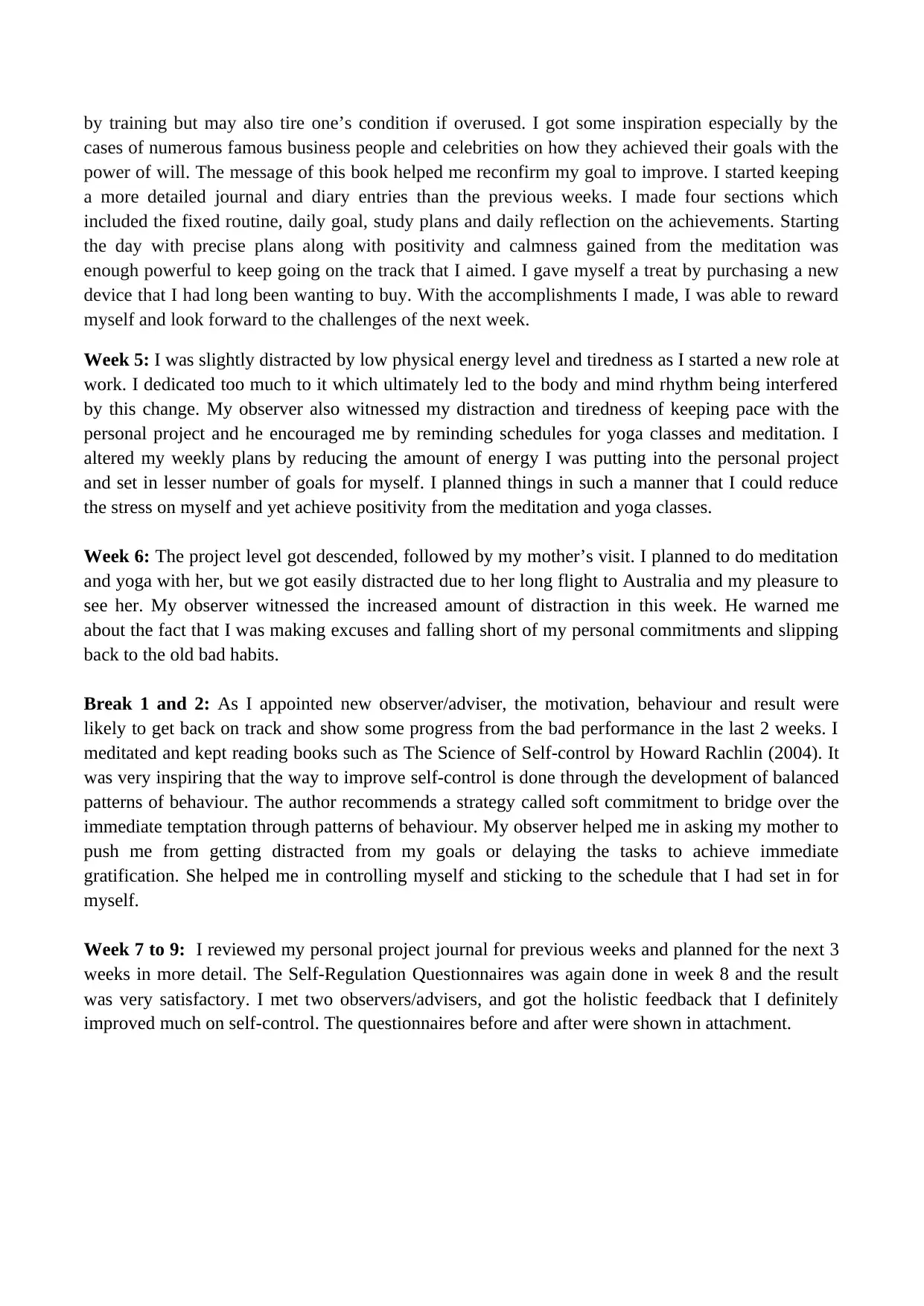
by training but may also tire one’s condition if overused. I got some inspiration especially by the
cases of numerous famous business people and celebrities on how they achieved their goals with the
power of will. The message of this book helped me reconfirm my goal to improve. I started keeping
a more detailed journal and diary entries than the previous weeks. I made four sections which
included the fixed routine, daily goal, study plans and daily reflection on the achievements. Starting
the day with precise plans along with positivity and calmness gained from the meditation was
enough powerful to keep going on the track that I aimed. I gave myself a treat by purchasing a new
device that I had long been wanting to buy. With the accomplishments I made, I was able to reward
myself and look forward to the challenges of the next week.
Week 5: I was slightly distracted by low physical energy level and tiredness as I started a new role at
work. I dedicated too much to it which ultimately led to the body and mind rhythm being interfered
by this change. My observer also witnessed my distraction and tiredness of keeping pace with the
personal project and he encouraged me by reminding schedules for yoga classes and meditation. I
altered my weekly plans by reducing the amount of energy I was putting into the personal project
and set in lesser number of goals for myself. I planned things in such a manner that I could reduce
the stress on myself and yet achieve positivity from the meditation and yoga classes.
Week 6: The project level got descended, followed by my mother’s visit. I planned to do meditation
and yoga with her, but we got easily distracted due to her long flight to Australia and my pleasure to
see her. My observer witnessed the increased amount of distraction in this week. He warned me
about the fact that I was making excuses and falling short of my personal commitments and slipping
back to the old bad habits.
Break 1 and 2: As I appointed new observer/adviser, the motivation, behaviour and result were
likely to get back on track and show some progress from the bad performance in the last 2 weeks. I
meditated and kept reading books such as The Science of Self-control by Howard Rachlin (2004). It
was very inspiring that the way to improve self-control is done through the development of balanced
patterns of behaviour. The author recommends a strategy called soft commitment to bridge over the
immediate temptation through patterns of behaviour. My observer helped me in asking my mother to
push me from getting distracted from my goals or delaying the tasks to achieve immediate
gratification. She helped me in controlling myself and sticking to the schedule that I had set in for
myself.
Week 7 to 9: I reviewed my personal project journal for previous weeks and planned for the next 3
weeks in more detail. The Self-Regulation Questionnaires was again done in week 8 and the result
was very satisfactory. I met two observers/advisers, and got the holistic feedback that I definitely
improved much on self-control. The questionnaires before and after were shown in attachment.
cases of numerous famous business people and celebrities on how they achieved their goals with the
power of will. The message of this book helped me reconfirm my goal to improve. I started keeping
a more detailed journal and diary entries than the previous weeks. I made four sections which
included the fixed routine, daily goal, study plans and daily reflection on the achievements. Starting
the day with precise plans along with positivity and calmness gained from the meditation was
enough powerful to keep going on the track that I aimed. I gave myself a treat by purchasing a new
device that I had long been wanting to buy. With the accomplishments I made, I was able to reward
myself and look forward to the challenges of the next week.
Week 5: I was slightly distracted by low physical energy level and tiredness as I started a new role at
work. I dedicated too much to it which ultimately led to the body and mind rhythm being interfered
by this change. My observer also witnessed my distraction and tiredness of keeping pace with the
personal project and he encouraged me by reminding schedules for yoga classes and meditation. I
altered my weekly plans by reducing the amount of energy I was putting into the personal project
and set in lesser number of goals for myself. I planned things in such a manner that I could reduce
the stress on myself and yet achieve positivity from the meditation and yoga classes.
Week 6: The project level got descended, followed by my mother’s visit. I planned to do meditation
and yoga with her, but we got easily distracted due to her long flight to Australia and my pleasure to
see her. My observer witnessed the increased amount of distraction in this week. He warned me
about the fact that I was making excuses and falling short of my personal commitments and slipping
back to the old bad habits.
Break 1 and 2: As I appointed new observer/adviser, the motivation, behaviour and result were
likely to get back on track and show some progress from the bad performance in the last 2 weeks. I
meditated and kept reading books such as The Science of Self-control by Howard Rachlin (2004). It
was very inspiring that the way to improve self-control is done through the development of balanced
patterns of behaviour. The author recommends a strategy called soft commitment to bridge over the
immediate temptation through patterns of behaviour. My observer helped me in asking my mother to
push me from getting distracted from my goals or delaying the tasks to achieve immediate
gratification. She helped me in controlling myself and sticking to the schedule that I had set in for
myself.
Week 7 to 9: I reviewed my personal project journal for previous weeks and planned for the next 3
weeks in more detail. The Self-Regulation Questionnaires was again done in week 8 and the result
was very satisfactory. I met two observers/advisers, and got the holistic feedback that I definitely
improved much on self-control. The questionnaires before and after were shown in attachment.
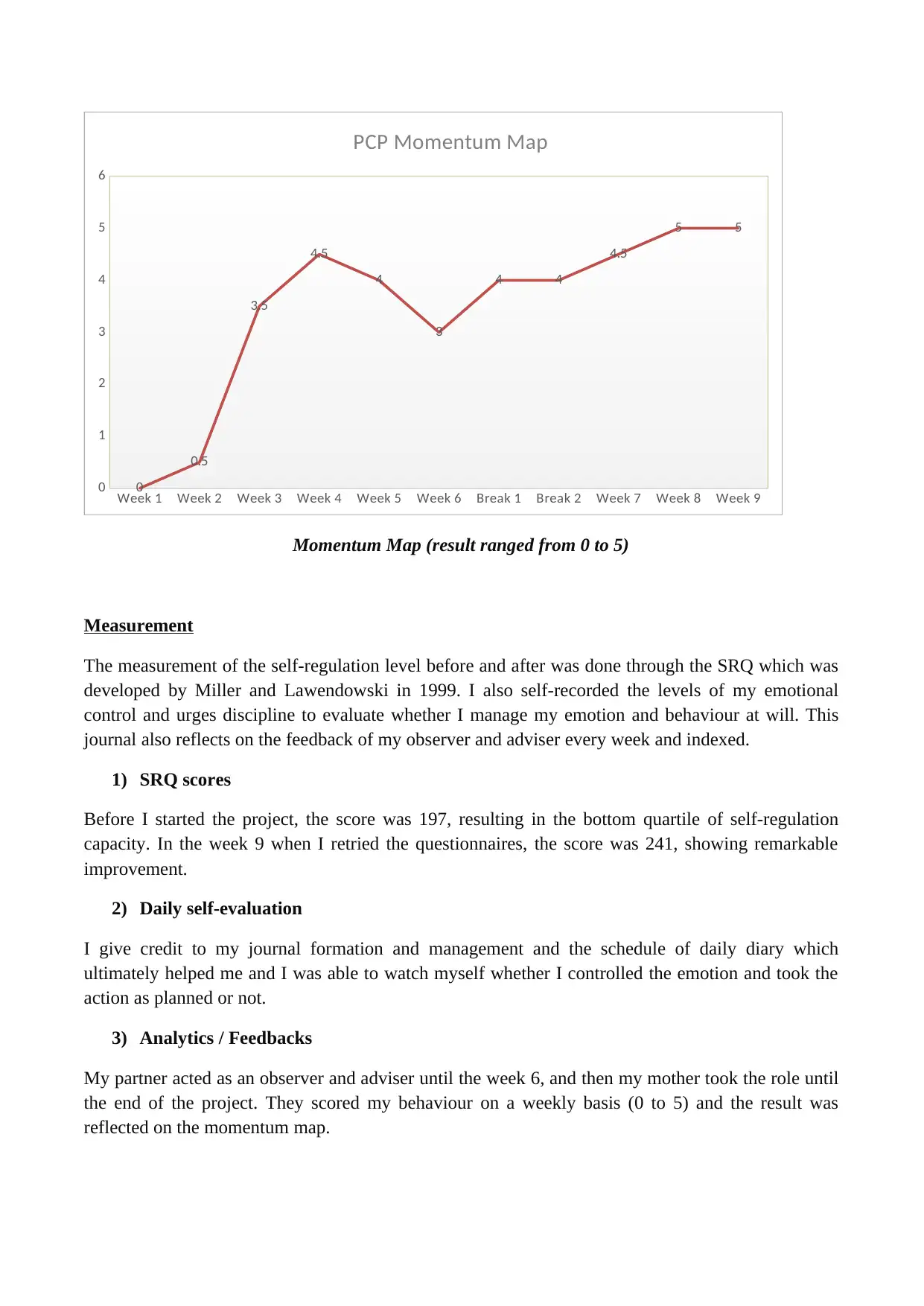
Week 1 Week 2 Week 3 Week 4 Week 5 Week 6 Break 1 Break 2 Week 7 Week 8 Week 9
0
1
2
3
4
5
6
0
0.5
3.5
4.5
4
3
4 4
4.5
5 5
PCP Momentum Map
Momentum Map (result ranged from 0 to 5)
Measurement
The measurement of the self-regulation level before and after was done through the SRQ which was
developed by Miller and Lawendowski in 1999. I also self-recorded the levels of my emotional
control and urges discipline to evaluate whether I manage my emotion and behaviour at will. This
journal also reflects on the feedback of my observer and adviser every week and indexed.
1) SRQ scores
Before I started the project, the score was 197, resulting in the bottom quartile of self-regulation
capacity. In the week 9 when I retried the questionnaires, the score was 241, showing remarkable
improvement.
2) Daily self-evaluation
I give credit to my journal formation and management and the schedule of daily diary which
ultimately helped me and I was able to watch myself whether I controlled the emotion and took the
action as planned or not.
3) Analytics / Feedbacks
My partner acted as an observer and adviser until the week 6, and then my mother took the role until
the end of the project. They scored my behaviour on a weekly basis (0 to 5) and the result was
reflected on the momentum map.
0
1
2
3
4
5
6
0
0.5
3.5
4.5
4
3
4 4
4.5
5 5
PCP Momentum Map
Momentum Map (result ranged from 0 to 5)
Measurement
The measurement of the self-regulation level before and after was done through the SRQ which was
developed by Miller and Lawendowski in 1999. I also self-recorded the levels of my emotional
control and urges discipline to evaluate whether I manage my emotion and behaviour at will. This
journal also reflects on the feedback of my observer and adviser every week and indexed.
1) SRQ scores
Before I started the project, the score was 197, resulting in the bottom quartile of self-regulation
capacity. In the week 9 when I retried the questionnaires, the score was 241, showing remarkable
improvement.
2) Daily self-evaluation
I give credit to my journal formation and management and the schedule of daily diary which
ultimately helped me and I was able to watch myself whether I controlled the emotion and took the
action as planned or not.
3) Analytics / Feedbacks
My partner acted as an observer and adviser until the week 6, and then my mother took the role until
the end of the project. They scored my behaviour on a weekly basis (0 to 5) and the result was
reflected on the momentum map.
⊘ This is a preview!⊘
Do you want full access?
Subscribe today to unlock all pages.

Trusted by 1+ million students worldwide
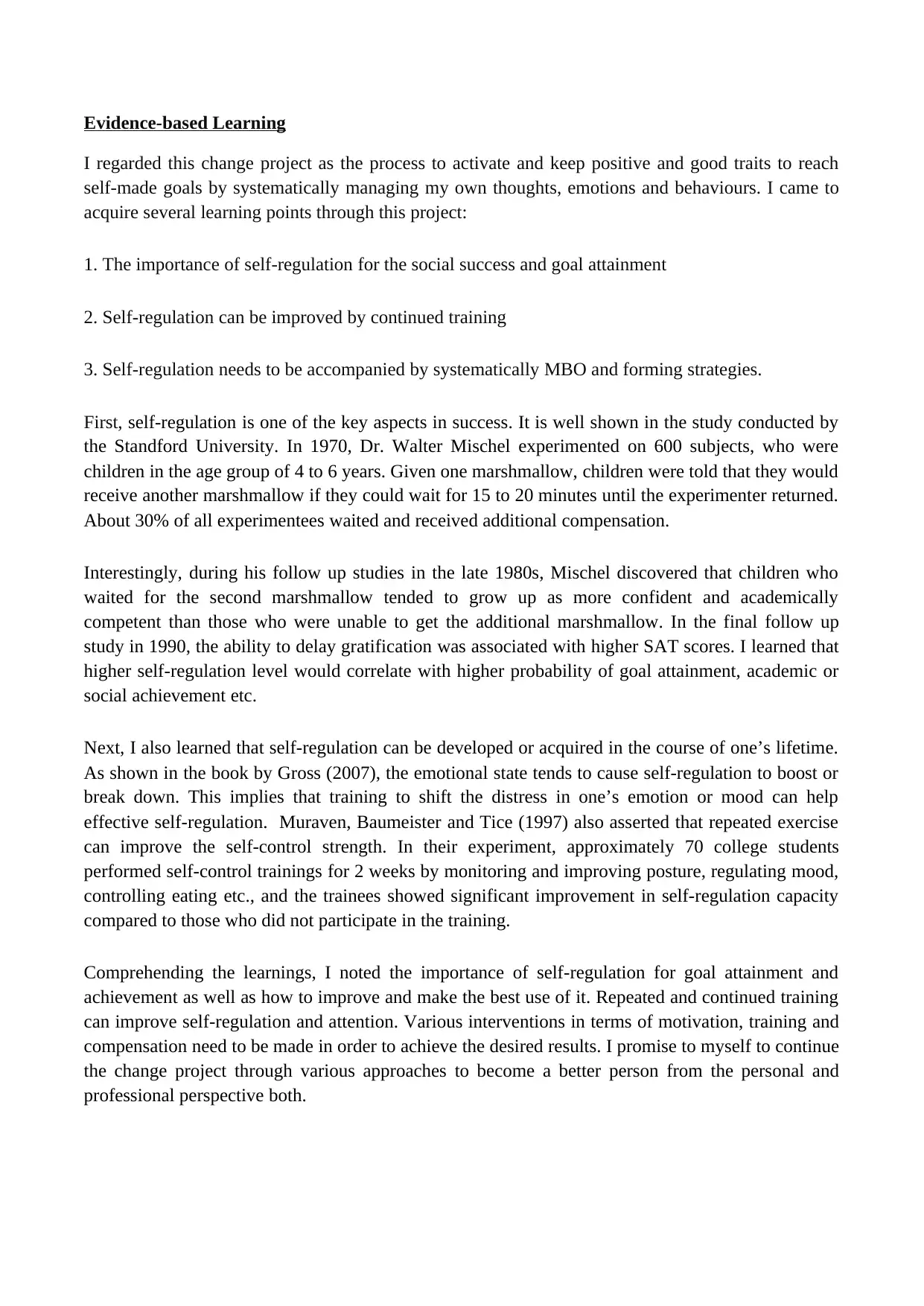
Evidence-based Learning
I regarded this change project as the process to activate and keep positive and good traits to reach
self-made goals by systematically managing my own thoughts, emotions and behaviours. I came to
acquire several learning points through this project:
1. The importance of self-regulation for the social success and goal attainment
2. Self-regulation can be improved by continued training
3. Self-regulation needs to be accompanied by systematically MBO and forming strategies.
First, self-regulation is one of the key aspects in success. It is well shown in the study conducted by
the Standford University. In 1970, Dr. Walter Mischel experimented on 600 subjects, who were
children in the age group of 4 to 6 years. Given one marshmallow, children were told that they would
receive another marshmallow if they could wait for 15 to 20 minutes until the experimenter returned.
About 30% of all experimentees waited and received additional compensation.
Interestingly, during his follow up studies in the late 1980s, Mischel discovered that children who
waited for the second marshmallow tended to grow up as more confident and academically
competent than those who were unable to get the additional marshmallow. In the final follow up
study in 1990, the ability to delay gratification was associated with higher SAT scores. I learned that
higher self-regulation level would correlate with higher probability of goal attainment, academic or
social achievement etc.
Next, I also learned that self-regulation can be developed or acquired in the course of one’s lifetime.
As shown in the book by Gross (2007), the emotional state tends to cause self-regulation to boost or
break down. This implies that training to shift the distress in one’s emotion or mood can help
effective self-regulation. Muraven, Baumeister and Tice (1997) also asserted that repeated exercise
can improve the self-control strength. In their experiment, approximately 70 college students
performed self-control trainings for 2 weeks by monitoring and improving posture, regulating mood,
controlling eating etc., and the trainees showed significant improvement in self-regulation capacity
compared to those who did not participate in the training.
Comprehending the learnings, I noted the importance of self-regulation for goal attainment and
achievement as well as how to improve and make the best use of it. Repeated and continued training
can improve self-regulation and attention. Various interventions in terms of motivation, training and
compensation need to be made in order to achieve the desired results. I promise to myself to continue
the change project through various approaches to become a better person from the personal and
professional perspective both.
I regarded this change project as the process to activate and keep positive and good traits to reach
self-made goals by systematically managing my own thoughts, emotions and behaviours. I came to
acquire several learning points through this project:
1. The importance of self-regulation for the social success and goal attainment
2. Self-regulation can be improved by continued training
3. Self-regulation needs to be accompanied by systematically MBO and forming strategies.
First, self-regulation is one of the key aspects in success. It is well shown in the study conducted by
the Standford University. In 1970, Dr. Walter Mischel experimented on 600 subjects, who were
children in the age group of 4 to 6 years. Given one marshmallow, children were told that they would
receive another marshmallow if they could wait for 15 to 20 minutes until the experimenter returned.
About 30% of all experimentees waited and received additional compensation.
Interestingly, during his follow up studies in the late 1980s, Mischel discovered that children who
waited for the second marshmallow tended to grow up as more confident and academically
competent than those who were unable to get the additional marshmallow. In the final follow up
study in 1990, the ability to delay gratification was associated with higher SAT scores. I learned that
higher self-regulation level would correlate with higher probability of goal attainment, academic or
social achievement etc.
Next, I also learned that self-regulation can be developed or acquired in the course of one’s lifetime.
As shown in the book by Gross (2007), the emotional state tends to cause self-regulation to boost or
break down. This implies that training to shift the distress in one’s emotion or mood can help
effective self-regulation. Muraven, Baumeister and Tice (1997) also asserted that repeated exercise
can improve the self-control strength. In their experiment, approximately 70 college students
performed self-control trainings for 2 weeks by monitoring and improving posture, regulating mood,
controlling eating etc., and the trainees showed significant improvement in self-regulation capacity
compared to those who did not participate in the training.
Comprehending the learnings, I noted the importance of self-regulation for goal attainment and
achievement as well as how to improve and make the best use of it. Repeated and continued training
can improve self-regulation and attention. Various interventions in terms of motivation, training and
compensation need to be made in order to achieve the desired results. I promise to myself to continue
the change project through various approaches to become a better person from the personal and
professional perspective both.
Paraphrase This Document
Need a fresh take? Get an instant paraphrase of this document with our AI Paraphraser
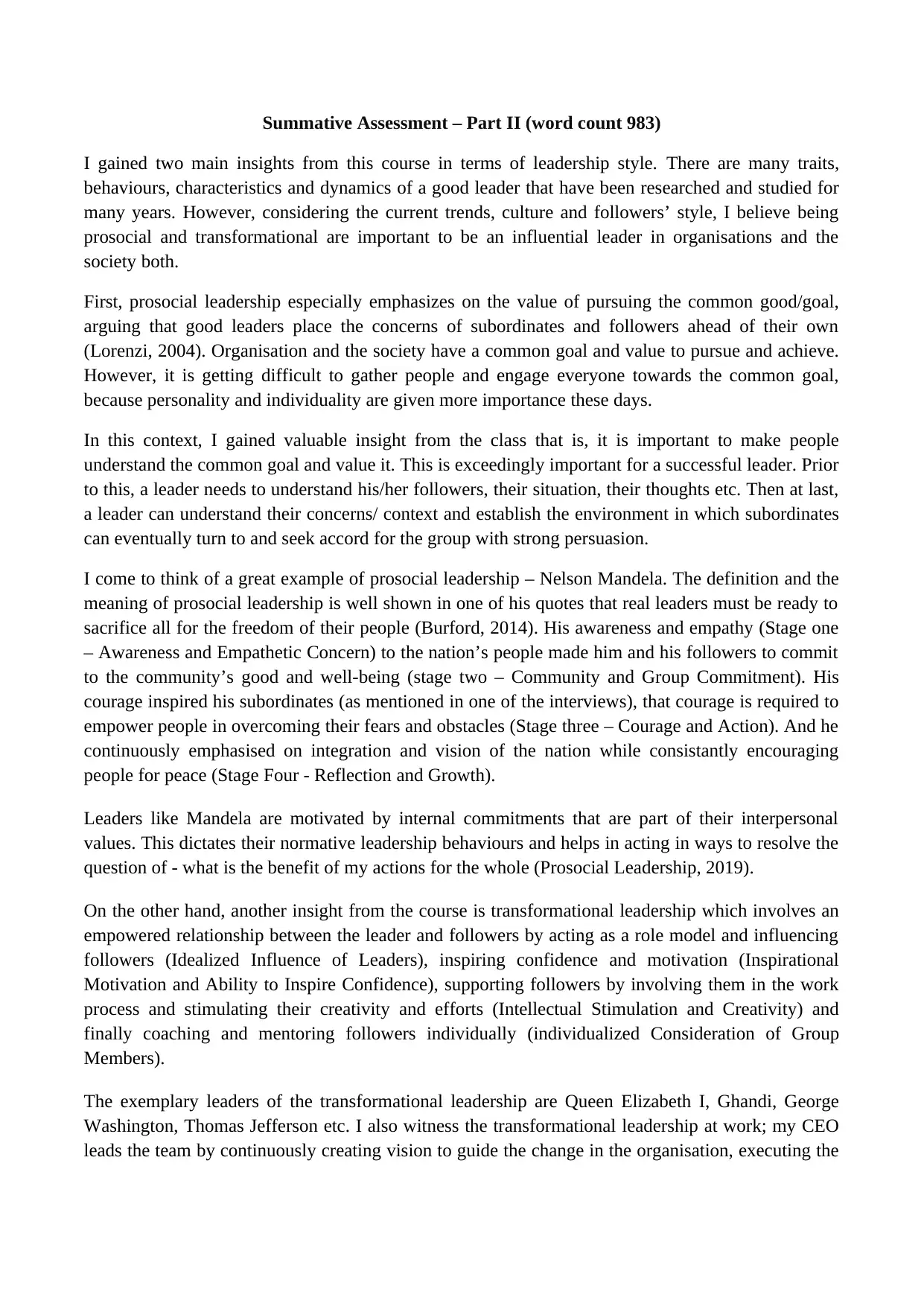
Summative Assessment – Part II (word count 983)
I gained two main insights from this course in terms of leadership style. There are many traits,
behaviours, characteristics and dynamics of a good leader that have been researched and studied for
many years. However, considering the current trends, culture and followers’ style, I believe being
prosocial and transformational are important to be an influential leader in organisations and the
society both.
First, prosocial leadership especially emphasizes on the value of pursuing the common good/goal,
arguing that good leaders place the concerns of subordinates and followers ahead of their own
(Lorenzi, 2004). Organisation and the society have a common goal and value to pursue and achieve.
However, it is getting difficult to gather people and engage everyone towards the common goal,
because personality and individuality are given more importance these days.
In this context, I gained valuable insight from the class that is, it is important to make people
understand the common goal and value it. This is exceedingly important for a successful leader. Prior
to this, a leader needs to understand his/her followers, their situation, their thoughts etc. Then at last,
a leader can understand their concerns/ context and establish the environment in which subordinates
can eventually turn to and seek accord for the group with strong persuasion.
I come to think of a great example of prosocial leadership – Nelson Mandela. The definition and the
meaning of prosocial leadership is well shown in one of his quotes that real leaders must be ready to
sacrifice all for the freedom of their people (Burford, 2014). His awareness and empathy (Stage one
– Awareness and Empathetic Concern) to the nation’s people made him and his followers to commit
to the community’s good and well-being (stage two – Community and Group Commitment). His
courage inspired his subordinates (as mentioned in one of the interviews), that courage is required to
empower people in overcoming their fears and obstacles (Stage three – Courage and Action). And he
continuously emphasised on integration and vision of the nation while consistantly encouraging
people for peace (Stage Four - Reflection and Growth).
Leaders like Mandela are motivated by internal commitments that are part of their interpersonal
values. This dictates their normative leadership behaviours and helps in acting in ways to resolve the
question of - what is the benefit of my actions for the whole (Prosocial Leadership, 2019).
On the other hand, another insight from the course is transformational leadership which involves an
empowered relationship between the leader and followers by acting as a role model and influencing
followers (Idealized Influence of Leaders), inspiring confidence and motivation (Inspirational
Motivation and Ability to Inspire Confidence), supporting followers by involving them in the work
process and stimulating their creativity and efforts (Intellectual Stimulation and Creativity) and
finally coaching and mentoring followers individually (individualized Consideration of Group
Members).
The exemplary leaders of the transformational leadership are Queen Elizabeth I, Ghandi, George
Washington, Thomas Jefferson etc. I also witness the transformational leadership at work; my CEO
leads the team by continuously creating vision to guide the change in the organisation, executing the
I gained two main insights from this course in terms of leadership style. There are many traits,
behaviours, characteristics and dynamics of a good leader that have been researched and studied for
many years. However, considering the current trends, culture and followers’ style, I believe being
prosocial and transformational are important to be an influential leader in organisations and the
society both.
First, prosocial leadership especially emphasizes on the value of pursuing the common good/goal,
arguing that good leaders place the concerns of subordinates and followers ahead of their own
(Lorenzi, 2004). Organisation and the society have a common goal and value to pursue and achieve.
However, it is getting difficult to gather people and engage everyone towards the common goal,
because personality and individuality are given more importance these days.
In this context, I gained valuable insight from the class that is, it is important to make people
understand the common goal and value it. This is exceedingly important for a successful leader. Prior
to this, a leader needs to understand his/her followers, their situation, their thoughts etc. Then at last,
a leader can understand their concerns/ context and establish the environment in which subordinates
can eventually turn to and seek accord for the group with strong persuasion.
I come to think of a great example of prosocial leadership – Nelson Mandela. The definition and the
meaning of prosocial leadership is well shown in one of his quotes that real leaders must be ready to
sacrifice all for the freedom of their people (Burford, 2014). His awareness and empathy (Stage one
– Awareness and Empathetic Concern) to the nation’s people made him and his followers to commit
to the community’s good and well-being (stage two – Community and Group Commitment). His
courage inspired his subordinates (as mentioned in one of the interviews), that courage is required to
empower people in overcoming their fears and obstacles (Stage three – Courage and Action). And he
continuously emphasised on integration and vision of the nation while consistantly encouraging
people for peace (Stage Four - Reflection and Growth).
Leaders like Mandela are motivated by internal commitments that are part of their interpersonal
values. This dictates their normative leadership behaviours and helps in acting in ways to resolve the
question of - what is the benefit of my actions for the whole (Prosocial Leadership, 2019).
On the other hand, another insight from the course is transformational leadership which involves an
empowered relationship between the leader and followers by acting as a role model and influencing
followers (Idealized Influence of Leaders), inspiring confidence and motivation (Inspirational
Motivation and Ability to Inspire Confidence), supporting followers by involving them in the work
process and stimulating their creativity and efforts (Intellectual Stimulation and Creativity) and
finally coaching and mentoring followers individually (individualized Consideration of Group
Members).
The exemplary leaders of the transformational leadership are Queen Elizabeth I, Ghandi, George
Washington, Thomas Jefferson etc. I also witness the transformational leadership at work; my CEO
leads the team by continuously creating vision to guide the change in the organisation, executing the
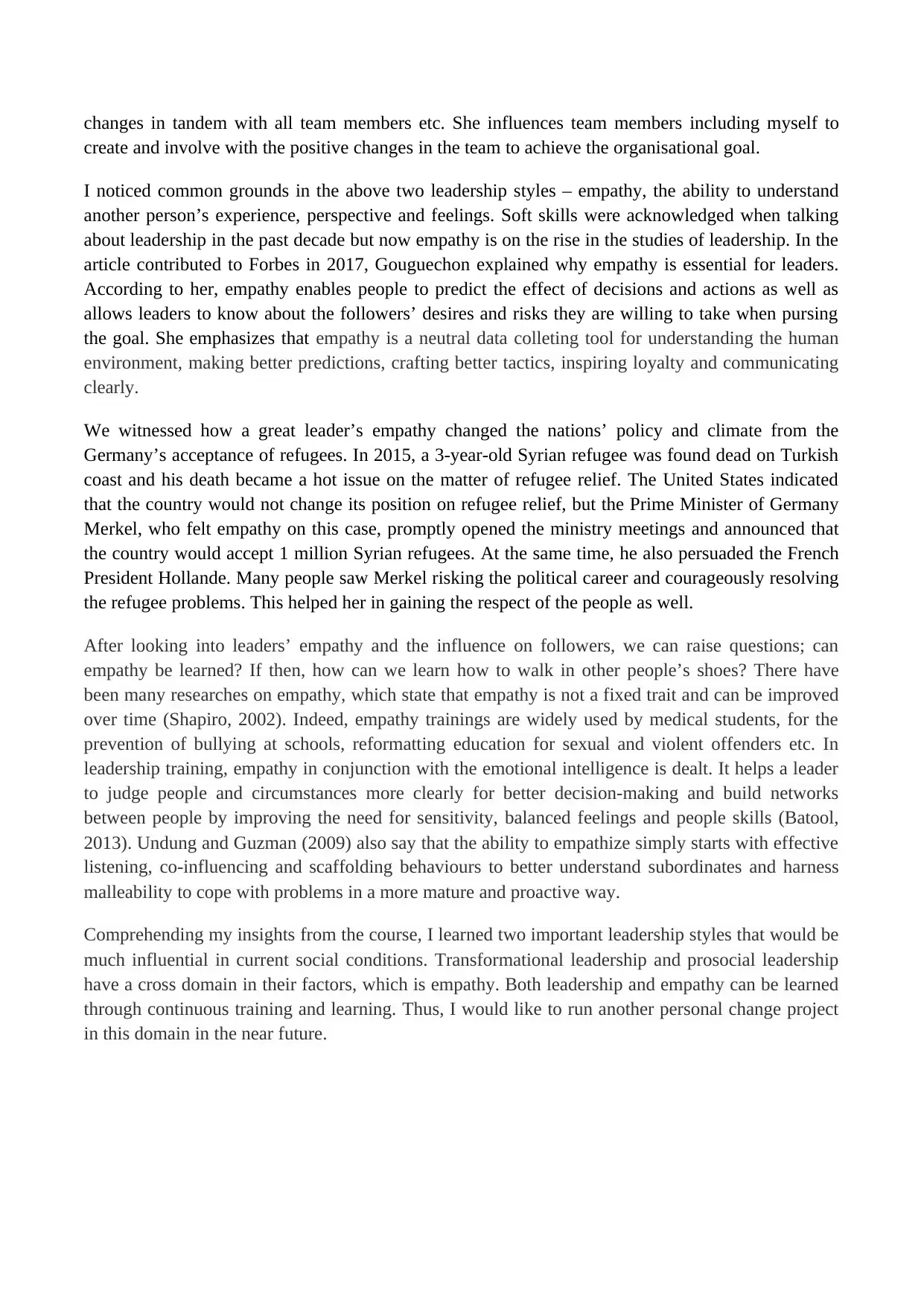
changes in tandem with all team members etc. She influences team members including myself to
create and involve with the positive changes in the team to achieve the organisational goal.
I noticed common grounds in the above two leadership styles – empathy, the ability to understand
another person’s experience, perspective and feelings. Soft skills were acknowledged when talking
about leadership in the past decade but now empathy is on the rise in the studies of leadership. In the
article contributed to Forbes in 2017, Gouguechon explained why empathy is essential for leaders.
According to her, empathy enables people to predict the effect of decisions and actions as well as
allows leaders to know about the followers’ desires and risks they are willing to take when pursing
the goal. She emphasizes that empathy is a neutral data colleting tool for understanding the human
environment, making better predictions, crafting better tactics, inspiring loyalty and communicating
clearly.
We witnessed how a great leader’s empathy changed the nations’ policy and climate from the
Germany’s acceptance of refugees. In 2015, a 3-year-old Syrian refugee was found dead on Turkish
coast and his death became a hot issue on the matter of refugee relief. The United States indicated
that the country would not change its position on refugee relief, but the Prime Minister of Germany
Merkel, who felt empathy on this case, promptly opened the ministry meetings and announced that
the country would accept 1 million Syrian refugees. At the same time, he also persuaded the French
President Hollande. Many people saw Merkel risking the political career and courageously resolving
the refugee problems. This helped her in gaining the respect of the people as well.
After looking into leaders’ empathy and the influence on followers, we can raise questions; can
empathy be learned? If then, how can we learn how to walk in other people’s shoes? There have
been many researches on empathy, which state that empathy is not a fixed trait and can be improved
over time (Shapiro, 2002). Indeed, empathy trainings are widely used by medical students, for the
prevention of bullying at schools, reformatting education for sexual and violent offenders etc. In
leadership training, empathy in conjunction with the emotional intelligence is dealt. It helps a leader
to judge people and circumstances more clearly for better decision-making and build networks
between people by improving the need for sensitivity, balanced feelings and people skills (Batool,
2013). Undung and Guzman (2009) also say that the ability to empathize simply starts with effective
listening, co-influencing and scaffolding behaviours to better understand subordinates and harness
malleability to cope with problems in a more mature and proactive way.
Comprehending my insights from the course, I learned two important leadership styles that would be
much influential in current social conditions. Transformational leadership and prosocial leadership
have a cross domain in their factors, which is empathy. Both leadership and empathy can be learned
through continuous training and learning. Thus, I would like to run another personal change project
in this domain in the near future.
create and involve with the positive changes in the team to achieve the organisational goal.
I noticed common grounds in the above two leadership styles – empathy, the ability to understand
another person’s experience, perspective and feelings. Soft skills were acknowledged when talking
about leadership in the past decade but now empathy is on the rise in the studies of leadership. In the
article contributed to Forbes in 2017, Gouguechon explained why empathy is essential for leaders.
According to her, empathy enables people to predict the effect of decisions and actions as well as
allows leaders to know about the followers’ desires and risks they are willing to take when pursing
the goal. She emphasizes that empathy is a neutral data colleting tool for understanding the human
environment, making better predictions, crafting better tactics, inspiring loyalty and communicating
clearly.
We witnessed how a great leader’s empathy changed the nations’ policy and climate from the
Germany’s acceptance of refugees. In 2015, a 3-year-old Syrian refugee was found dead on Turkish
coast and his death became a hot issue on the matter of refugee relief. The United States indicated
that the country would not change its position on refugee relief, but the Prime Minister of Germany
Merkel, who felt empathy on this case, promptly opened the ministry meetings and announced that
the country would accept 1 million Syrian refugees. At the same time, he also persuaded the French
President Hollande. Many people saw Merkel risking the political career and courageously resolving
the refugee problems. This helped her in gaining the respect of the people as well.
After looking into leaders’ empathy and the influence on followers, we can raise questions; can
empathy be learned? If then, how can we learn how to walk in other people’s shoes? There have
been many researches on empathy, which state that empathy is not a fixed trait and can be improved
over time (Shapiro, 2002). Indeed, empathy trainings are widely used by medical students, for the
prevention of bullying at schools, reformatting education for sexual and violent offenders etc. In
leadership training, empathy in conjunction with the emotional intelligence is dealt. It helps a leader
to judge people and circumstances more clearly for better decision-making and build networks
between people by improving the need for sensitivity, balanced feelings and people skills (Batool,
2013). Undung and Guzman (2009) also say that the ability to empathize simply starts with effective
listening, co-influencing and scaffolding behaviours to better understand subordinates and harness
malleability to cope with problems in a more mature and proactive way.
Comprehending my insights from the course, I learned two important leadership styles that would be
much influential in current social conditions. Transformational leadership and prosocial leadership
have a cross domain in their factors, which is empathy. Both leadership and empathy can be learned
through continuous training and learning. Thus, I would like to run another personal change project
in this domain in the near future.
⊘ This is a preview!⊘
Do you want full access?
Subscribe today to unlock all pages.

Trusted by 1+ million students worldwide
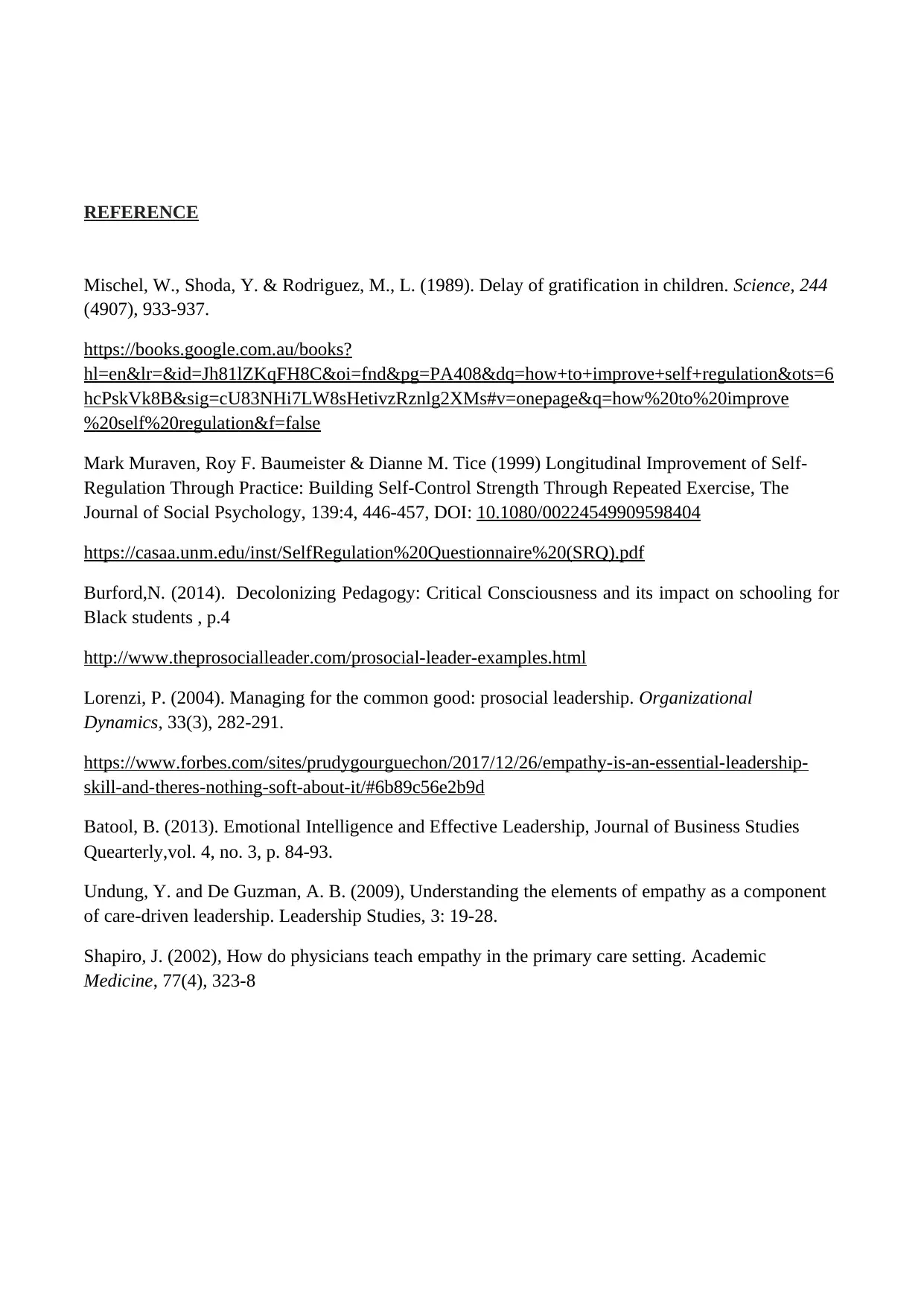
REFERENCE
Mischel, W., Shoda, Y. & Rodriguez, M., L. (1989). Delay of gratification in children. Science, 244
(4907), 933-937.
https://books.google.com.au/books?
hl=en&lr=&id=Jh81lZKqFH8C&oi=fnd&pg=PA408&dq=how+to+improve+self+regulation&ots=6
hcPskVk8B&sig=cU83NHi7LW8sHetivzRznlg2XMs#v=onepage&q=how%20to%20improve
%20self%20regulation&f=false
Mark Muraven, Roy F. Baumeister & Dianne M. Tice (1999) Longitudinal Improvement of Self-
Regulation Through Practice: Building Self-Control Strength Through Repeated Exercise, The
Journal of Social Psychology, 139:4, 446-457, DOI: 10.1080/00224549909598404
https://casaa.unm.edu/inst/SelfRegulation%20Questionnaire%20(SRQ).pdf
Burford,N. (2014). Decolonizing Pedagogy: Critical Consciousness and its impact on schooling for
Black students , p.4
http://www.theprosocialleader.com/prosocial-leader-examples.html
Lorenzi, P. (2004). Managing for the common good: prosocial leadership. Organizational
Dynamics, 33(3), 282-291.
https://www.forbes.com/sites/prudygourguechon/2017/12/26/empathy-is-an-essential-leadership-
skill-and-theres-nothing-soft-about-it/#6b89c56e2b9d
Batool, B. (2013). Emotional Intelligence and Effective Leadership, Journal of Business Studies
Quearterly,vol. 4, no. 3, p. 84-93.
Undung, Y. and De Guzman, A. B. (2009), Understanding the elements of empathy as a component
of care‐driven leadership. Leadership Studies, 3: 19-28.
Shapiro, J. (2002), How do physicians teach empathy in the primary care setting. Academic
Medicine, 77(4), 323-8
Mischel, W., Shoda, Y. & Rodriguez, M., L. (1989). Delay of gratification in children. Science, 244
(4907), 933-937.
https://books.google.com.au/books?
hl=en&lr=&id=Jh81lZKqFH8C&oi=fnd&pg=PA408&dq=how+to+improve+self+regulation&ots=6
hcPskVk8B&sig=cU83NHi7LW8sHetivzRznlg2XMs#v=onepage&q=how%20to%20improve
%20self%20regulation&f=false
Mark Muraven, Roy F. Baumeister & Dianne M. Tice (1999) Longitudinal Improvement of Self-
Regulation Through Practice: Building Self-Control Strength Through Repeated Exercise, The
Journal of Social Psychology, 139:4, 446-457, DOI: 10.1080/00224549909598404
https://casaa.unm.edu/inst/SelfRegulation%20Questionnaire%20(SRQ).pdf
Burford,N. (2014). Decolonizing Pedagogy: Critical Consciousness and its impact on schooling for
Black students , p.4
http://www.theprosocialleader.com/prosocial-leader-examples.html
Lorenzi, P. (2004). Managing for the common good: prosocial leadership. Organizational
Dynamics, 33(3), 282-291.
https://www.forbes.com/sites/prudygourguechon/2017/12/26/empathy-is-an-essential-leadership-
skill-and-theres-nothing-soft-about-it/#6b89c56e2b9d
Batool, B. (2013). Emotional Intelligence and Effective Leadership, Journal of Business Studies
Quearterly,vol. 4, no. 3, p. 84-93.
Undung, Y. and De Guzman, A. B. (2009), Understanding the elements of empathy as a component
of care‐driven leadership. Leadership Studies, 3: 19-28.
Shapiro, J. (2002), How do physicians teach empathy in the primary care setting. Academic
Medicine, 77(4), 323-8
Paraphrase This Document
Need a fresh take? Get an instant paraphrase of this document with our AI Paraphraser

Attachment
1 out of 8
Related Documents
Your All-in-One AI-Powered Toolkit for Academic Success.
+13062052269
info@desklib.com
Available 24*7 on WhatsApp / Email
![[object Object]](/_next/static/media/star-bottom.7253800d.svg)
Unlock your academic potential
Copyright © 2020–2025 A2Z Services. All Rights Reserved. Developed and managed by ZUCOL.





